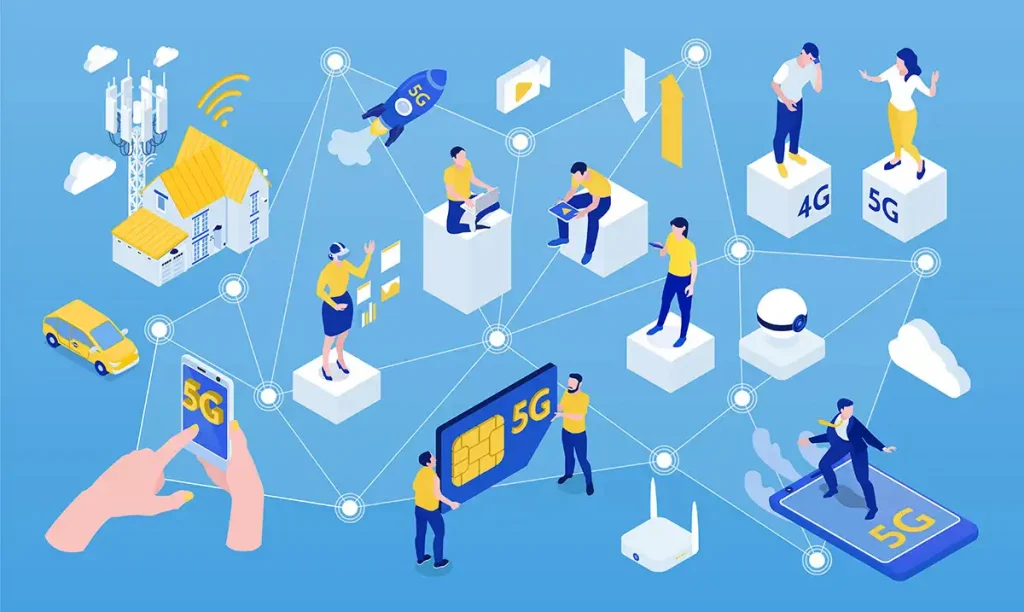Introduction
Today, wireless technology is omnipresent and has steadily become an inevitable part of most people’s everyday lives. Humans rely heavily on wireless tech for information consumption, entertainment, communication, and many more things. For example, wireless keyboards and mouse for computers, Bluetooth speakers, wireless headphones, and smart appliances with sensors are the most common things today.
Wireless communication involves transmission of electromagnetic signals over the air and can be done using radio frequency (RF) and infrared (IR) waves. RF is the real “things” in wireless and hence, in the Internet of Things solutions.
What is RF?
A measurement showing the oscillation rate of electromagnetic radio waves from frequencies ranging from 300 GHz(gigahertz) to 9 kHz (kilo hertz). The RF’s applications include various kinds of wireless broadcasting and communications.
Technologies like Wi-Fi, Bluetooth, ZigBee, IR, LPWAN (low-power wide-area network), LoRaWAN, NFC (Near Field Communication), cellular, LTE, 5G are examples of the how RF has helped in developing exceptional wireless technologies; these protocols can also be used to communicate with cloud platforms and applications apart from communicating device to device. It truly helps organizations to take advantage of the latest technologies like AI/ML, AR/VR to offer better customer experience to their users.
Wireless technologies have also enabled the development of new services and applications that can be used to improve business processes and the customer experience. Wireless tech has become the heart of today’s innovations – Be it self-driving vehicles, smart audio/video devices, autonomous machines, robots, drones, or other IoT (Internet of Things) solutions and services.
Advantages Of Wireless and RF Tech.
The dependency on wireless tech and RF will only get stronger mostly because of the various advantages they offer in terms of the ability to broadcast, increased mobility and security, easy access and convenience, installation, and scalability. It also allows many devices to be connected to the same network, enabling the creation of a cluster of IoT devices.
- Increased mobility with great speed and convenience: It allows users to connect devices from various locations and access required information from anywhere, anytime at lightning speed if there is an already established connection.
- Ability to broadcast: The second major advantage is its ability to do broadcast communications – A single transmitter can feed data to hundreds of thousands of receivers if they all receive the same information.
- Easy installation: Much easier to install as compared to wired networks as there are no cables to be run which is the most difficult and time-consuming process.
- Security: More secure than wired technologies because wireless communication use encryption protocols which makes it difficult for an unauthorized user to access the network.
- Scalability: Wireless networks can easily be scaled up or down depending on the need without much additional effort. A new user can also be added at no cost to existing infrastructure and that too without compromising security.
How Wireless and RF Helps in Building Engineering Solutions for Various Industries
Businesses including healthcare, industrial and home automation, aerospace, and defense, automotive, security and surveillance, retail, transport/logistics, and many more have immensely benefited from the RF technology, and it won’t be wrong to say that the wireless technologies have played an integral role in shaping the world that we see today.
Smart Factories, Warehouses, And Logistics
Workers can easily run and inspect factories, production lines or warehouses remotely. Imagining a smart factory or warehouse without humans, in the current times, is still believable but not without robots. In smart factories, autonomous machines cannot do their job and make factories SMARTER without wireless; warehouses need lots of wireless devices and sensors other than robots to keep them operational. Additionally, wireless networks not only accelerate production but also help in keeping the workers safe.
Healthcare
Wireless tech is a boon to the healthcare industry. We have experienced this during the COVID-19 pandemic – Doctors can serve patients through telehealth visits which can improve the accessibility of people to healthcare. Moreover, medical professionals can leverage RF and wireless technology like smart sensors that can detect certain medical conditions and provide remote assistance even in emergency situations.
Radio frequency technology is used in medical devices such as imaging & diagnostic systems, medical implants and prosthetics, and wireless medical monitoring. Wearables that can track sleep, heart rate, glucose level, exercise steps, and many more data points can use low-powered radiofrequency (RF) transmitters to communicate with smart phones or the internet. Doctors can then access the information in real time and take decisions about their patients’ care and treatment.
Aerospace and Defense
UAVs (Unmanned Aerial Vehicles), equipped with wireless communication systems, are increasingly being used for military and defense applications as they provide much-needed control, communications, and navigation capabilities. Autonomous systems are also being utilized for surveillance, reconnaissance, search-and-rescue operations, and missile guidance in aerospace and defense applications.
Aircraft maintenance can be done remotely using wireless systems that can provide real-time maintenance and repair data which can further help in ensuring safety and reliability. Air traffic control is another area where these systems with control and navigation capabilities can be of significant help which ensures the safety of aircraft in flight.
Automotive
Some of the most popular automotive applications are remote keyless entry, GPS navigation, in-car entertainment, hands-free calling, Wi-Fi hotspots, and wireless charging which is not possible without wireless and RF technology. Another major area where wireless tech offers an extra edge to automotive manufacturers is remote diagnostics of automobiles – It allows technicians to diagnose a car’s problem remotely and even send software updates over the air. Self-driving cars need V2X systems enabled by wireless to communicate with everything including other vehicles and road infrastructure.
Industrial and Home automation
Wireless sensor networks and RF technology allow industrial automation systems to monitor conditions over long distances and hard-to-reach places, providing real-time data on environmental conditions, machinery performance, and safety. It can also control industrial robots, automated production lines, and other industrial processes including manufacturing, transportation, and distribution. Thus, improving efficiency, reducing waste, and increasing productivity.
Smart home hubs allow users to control and automate their entire home in terms of lighting, heating, and cooling, and security with a single device. Wireless lighting systems allow users to control their lights remotely and schedule the lighting behavior according to the time or in response to certain events. This helps in saving energy and enhancing safety with great comfort and convenience. Radio frequency technology is used in security systems such as burglar alarms and access control systems to detect unwanted intruders. Wireless security systems allow users to monitor their homes for intrusion and other threats, providing real-time alerts and allowing remote access.
Retail
Mobile point-of-sale (mPOS) systems are now common in retail stores to facilitate transactions, allowing customers to make payments using their mobile devices. These systems often use wireless technology, such as BT(Bluetooth) or NFC (Near Field Communication). Radio frequency technology has also revolutionized the retail stores by making tasks such as inventory tracking and managing customer checkouts seamless -RFID tags enable retailers to keep real-time track of what is in stock and what needs to be reordered, reducing the need for manual data entry, and providing more accurate inventory management. This can also help in optimizing store layouts by collecting data about customers’ in-store behavior and then utilizing the data to engage with them through personalized offers.
To accelerate global wireless innovation, eInfochips provides a comprehensive set of wireless and RF services including antenna design and custom wireless product development by leveraging . Contact us to know how we are helping companies in taking their wireless and RF products from concept to market quickly through best-in-class device cost and time to volume.












